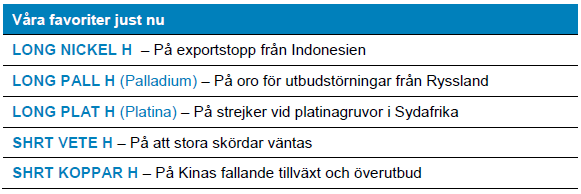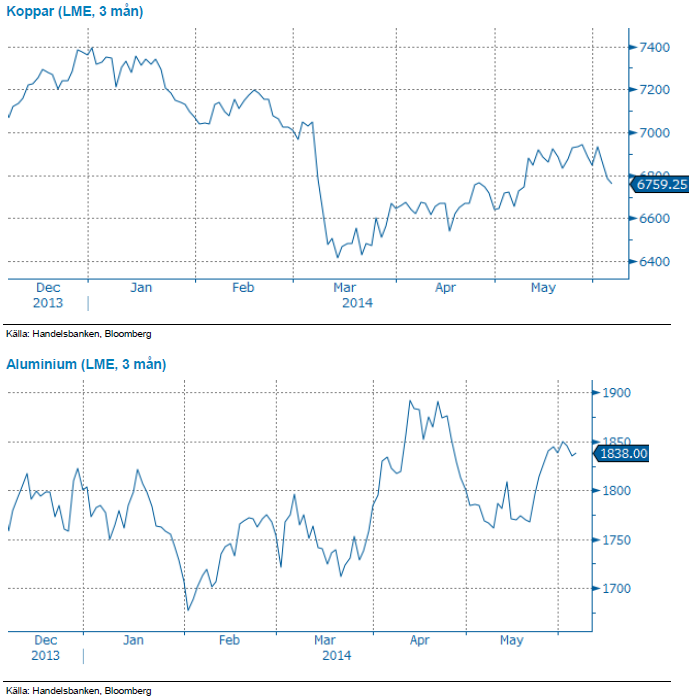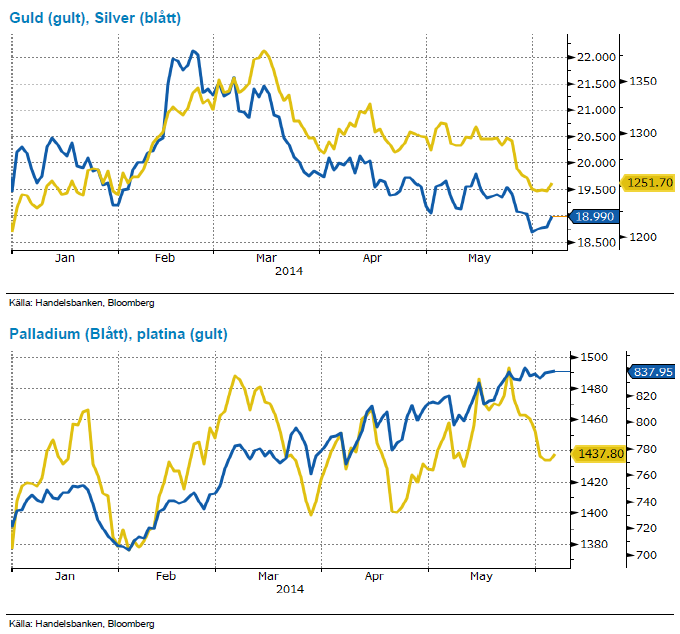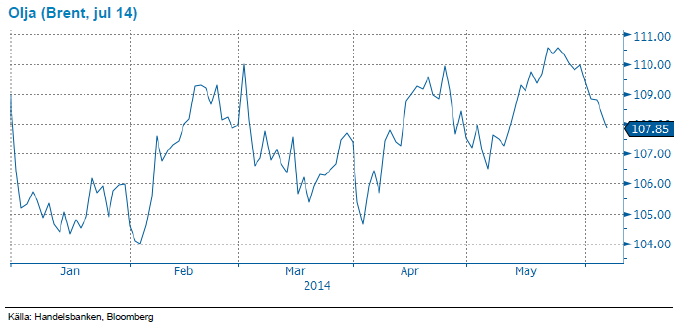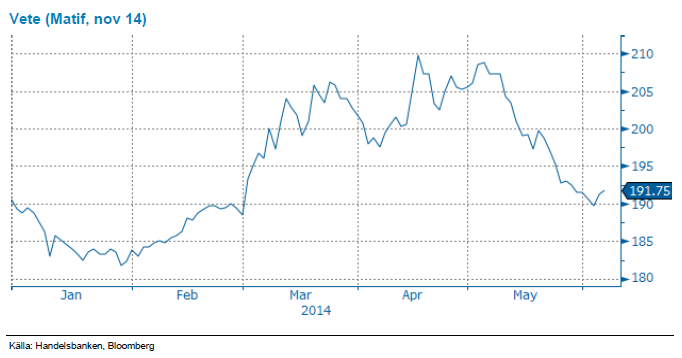Analys
SHB Råvarubrevet 5 juni 2014

Råvaror allmänt: Har Kina bottnat för detta året?
 Veckans snackis på marknaden har varit förväntansbilden på ECB. Den Europeiska centralbanken levererade en sänkning enligt förväntansbilden och är inte en stor sak för råvarumarknaden.
Veckans snackis på marknaden har varit förväntansbilden på ECB. Den Europeiska centralbanken levererade en sänkning enligt förväntansbilden och är inte en stor sak för råvarumarknaden.
Kinas fallande tillväxt har varit huvudrubriken för råvarumarknaden de senaste två åren. Efter första kvartalets dramatiska nedgång i barometerdata ser nu åtminstone inköpschefsindex ut att ha planat ut. Vi tror att stimulanserna av efterfrågan har stoppat nedgången för den här gången. Det är dock enbart en tillfällig lösning och den långa trenden är fortfarande nedåt för kinesisk tillväxt. Främst drabbar detta koppar vars efterfrågan är beroende av kinesisk byggsektor samtidigt som produktionen ökar efter år av investeringar i världens gruvor. Övriga basmetaller ser vi ganska ljust på just nu, begränsad nedsida från låga nivåer och inte alls samma strukturella press från ökad produktion som för koppar gör att vår bild på basmetallkomplexet blir negativ på koppar men positiv på övriga.
Vår tro på klart lägre oljepriser den här våren har grusats. Riskpremien från Ryssland-Ukraina och det faktum att Libyen inte kommit tillbaka till export i den utsträckning som vi tänkt har hindrat det säsongsmässiga prisfall vi brukar se under andra kvartalet. Nu tror vi istället att oljan får stöd av stundande ”driving season” och byter delvis fot även om vi på ett eller två års sikt tror att oljan kommer pressas av ökad produktion i USA.
För vetet anses putinpremien nu var utvädrad men vi fortsätter tro på lägre pris då stora skördar väntas vid skörd. Från att varit positiva till guldet skiftar vi till en mer neutral vy, läs mer nedan.
Basmetaller: Små rörelser under veckan
Vi har inga stora rörelser att rapportera om för basmetallerna senaste veckan, störst rörelser ser vi på koppar som tappat 1,8 %. Kinas PMI (HSBC) för tillverkningsindustrin reviderades ned till 49,4 från det preliminära på 49,7 vilket har hållit ned priset på metallerna under veckan.
Vi ser positivt på basmetaller med undantaget för koppar som pressas av Kina och överutbud. Aluminium har vi tidigare satt ett intervall på 1800-2000 USD/ton de kommande åren och med dagens pris på 1850 finns det utrymme kvar på uppsidan. Det stora nickelrallyt ser ut vara över men vi behåller vår positiva vy och tror att priset ska fortsätta upp under året. Vi tror att zink kommer bli nästa metall som kan bjuda på ett prisrally då det låga priset kan tvinga många gruvor ur produktion, men det dröjer ytterligare innan detta sker.
Ädelmetaller: Vi blir neutrala till guldet
Efter drygt två månader av konsolidering i intervalet 1280-1320 dollar per uns föll guldpriset ned under 1250 dollar, och har inte visat på några nämnvärda rekyltendenser sedan dess. Nu står marknaden dock och väger mellan rädsla över räntehöjningar i USA och förhoppningar om stimulans i Euroland, och vi väljer att nu tona ner den positiva syn vi haft på guldet till en mer neutral vy.
Dock fortsätter gruvstrejkerna i Sydafrika, och beräkningar nu pekar på att så mycket som 25 % av årsproduktionen av platina kommer att falla bort under 2014. 87 % av världens platinareserver finns i Sydafrika, och tre stora producenter (Anglo Platinum, Lonmin och Impala) dominerar marknaden totalt. Strejken har nu pågått i över fyra månader och marknaden kommer att hamna i större underskott ju längre den fortsätter. Samtidigt växer bilindustrin globalt och 2014 års bilförsäljning beräknas bli 5 procent högre än 2013, något som driver efterfrågan på platina och palladium. Striktare utsläppskrav på bilar i Kina kommer framöver att göra att förbrukningen av platina och palladium kommer att öka snabbare än bilproduktionen.
Vi behåller därför platina och palladium bland våra favoriter, av samma skäl som tidigare. Vi noterar också att dessa hanterat guldprisfallet bättre, platina har fallit något sedan senaste brevet, medan palladium stigit något.
Energi: Fallande pris på både olja och el
Riskpremien på oljemarknaden minskar efter att den geopolitiska spänningen i Ukraina och risken för vidare sanktioner mot Ryssland avtar något efter G7:s uttalande även om USA hotar med riktade sanktioner om Ryssland drar tillbaka sina trupper. Amerikansk lagerdata bidrar också till nedgången mot slutet av veckan.
Vi förväntar oss dock att oljan handlas kvar i denna range med stöd från osäkerheten kring framför allt Iran och Libyen i synnerhet, där situationen kring utbud och terminaler ser allt mörkare ut. I övrigt har det varit en hel del fokus på Obama-administrationens utsläppsplan, EPA (Environmental Protection Agency Plan) som presenterades tidigare i veckan. EPA skulle innebära att man reducerar koldioxidutsläppen med 30 procent fram till 2030 (från 2005 års nivåer) vilket i stort handlar om att man accelererar nedstängning av kolgenererad kraft till fördel för gasgenererad kraft. Planen, som inte lär träda i kraft förrän om två år, skiljer sig klart från tidigare och är ett stort slag mot den inhemska gruvindustrin (kol) vilken sysselsätter ca 800,000 personer. Kolgenererad kraft står idag för ca 37 % av generarad kraft i USA (ned från 52% år 2000) och beräknas fortsatt stå för ca 30% år 2030, men det lär till en början resultera i en ökad volym kol på exportmarknaden och indirekt pressa priset för kolgenererad kraft tills dess att ytterligare gruvor stängs ned.
Elen faller tillbaka och på bränslekomplexet har det varit enkelriktat, i synnerhet på gas och kolmarknaden som inte tycks vilja bottna ur. Gazprom fortsätter att skjuta på betalningstiden för Ukraina vilket minskat oron på gasmarknaden om än tillfälligt samtidigt som kolen är tillbaka på de tidigare låga nivåer som noterades i februari/mars som ett resultat av ett stort överskott och god tillgänglighet på exportmarknaden. Den negativa energibalansen stabiliserar marknaden något vilket även CO2 gjorde fram till det negativa beskedet om stabiliseringsmekanismen (i ett försök att minska överskottet på rätter) vilken nu ej planeras starta tidigare än väntat. Vi räknar därför inte med att kvartalet Q314 stiger mer utan att vi snarare tappar någon euro eller två ned mot 24-25 euro.
Livsmedel: Vetets putinpremie utvädrad
Vetepriset har fortsatt falla och handlas nu på samma nivå som när krisen i Ukraina intensifierades i början på mars. Vi fortsätter att tro på lägre priser då kommande skörd ser ut få alla förutsättningar för att bli stor.
Situationen har blivit något bättre för det amerikanska höstvetet som i dagarna fått ganska mycket välbehövligt regn. Vårvetet har haft lite torrare väder i dagarna men regn väntas till helgen – vilket ses som gynnsamt. I Kanada regnar det en del, vilket fördröjer en redan ganska sen sådd ytterligare något. Det australiensiska vetet har den senaste tiden upplevt ett varierande väder med tillfredställande mängd nederbörd. I Europa faller också en del regn, främst i regionens västra delar. Överlag ser grödorna i Europa väldigt fina ut – vilket vi ser även hemma i Sverige. Ukraina har också fått tillräckligt med regn men har nu blivit lite torrare, vilket gynnar den mognande grödan. Ryssland uppges ha lite blött i söder men de centrala delarna av landet är lite väl torrt och varmt – än så länge uppges dock oron vara begränsad. Med något förbättrad situation för det amerikanska vetet och fortsatt generellt sett väldigt gott skick på norra halvklotets grödor i övrigt är det svårt att se varför inte ytterligare prisfall är att vänta – givet att inga mer omfattande störningar inträffar, för vilket tiden rinner ut då skörd närmar sig.
Efter en längre period av torka under årets första månader ser nu nederbörden i april-maj komma som en sista minuten räddning för kaffeodlingarna i sydöstra Brasilien. Återhämtningen kan komma att dämpa produktionsbortfallet och skörden ser nu ut att vara i bättre skick än tidigare befarat. Den kommande veckan fortsätter att bli en behaglig mognadsperiod för kaffebönor som ännu inte skördats med relativt torrt väder och regn under normalen. Om ett par veckor släpper amerikanska jordbruksdepartementet, USDA, årets första prognos på den kommande skörden. Vi ser viss risk på nedsidan men håller en neutral vy i väntan på rapporten.
Handelsbankens råvaruindex (USD)
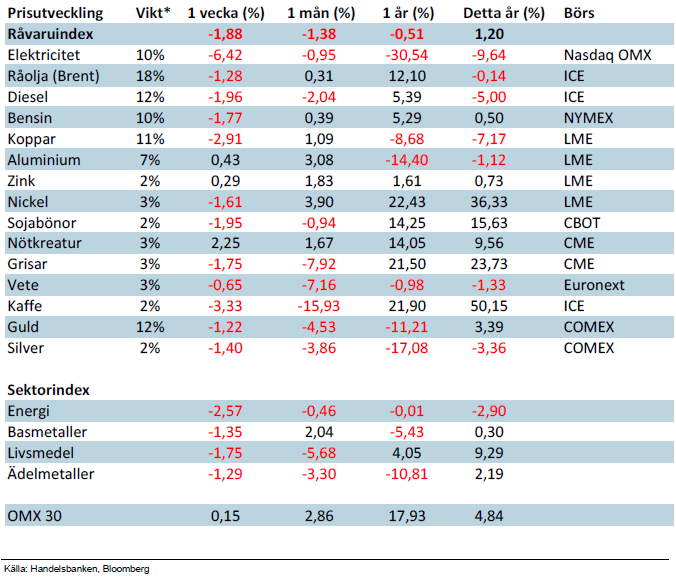
*Uppdaterade vikter från 29 november 2013
Handelsbankens råvaruindex består av de underliggande indexen för respektive råvara. Vikterna är bestämda till hälften från värdet av nordisk produktion (globala produktionen för sektorindex) och till hälften från likviditeten i terminskontrakten.
[box]SHB Råvarubrevet är producerat av Handelsbanken och publiceras i samarbete och med tillstånd på Råvarumarknaden.se[/box]
Ansvarsbegränsning
Detta material är producerat av Svenska Handelsbanken AB (publ) i fortsättningen kallad Handelsbanken. De som arbetar med innehållet är inte analytiker och materialet är inte oberoende investeringsanalys. Innehållet är uteslutande avsett för kunder i Sverige. Syftet är att ge en allmän information till Handelsbankens kunder och utgör inte ett personligt investeringsråd eller en personlig rekommendation. Informationen ska inte ensamt utgöra underlag för investeringsbeslut. Kunder bör inhämta råd från sina rådgivare och basera sina investeringsbeslut utifrån egen erfarenhet.
Informationen i materialet kan ändras och också avvika från de åsikter som uttrycks i oberoende investeringsanalyser från Handelsbanken. Informationen grundar sig på allmänt tillgänglig information och är hämtad från källor som bedöms som tillförlitliga, men riktigheten kan inte garanteras och informationen kan vara ofullständig eller nedkortad. Ingen del av förslaget får reproduceras eller distribueras till någon annan person utan att Handelsbanken dessförinnan lämnat sitt skriftliga medgivande. Handelsbanken ansvarar inte för att materialet används på ett sätt som strider mot förbudet mot vidarebefordran eller offentliggörs i strid med bankens regler.
Analys
Tightening fundamentals – bullish inventories from DOE

The latest weekly report from the US DOE showed a substantial drawdown across key petroleum categories, adding more upside potential to the fundamental picture.

Commercial crude inventories (excl. SPR) fell by 5.8 million barrels, bringing total inventories down to 415.1 million barrels. Now sitting 11% below the five-year seasonal norm and placed in the lowest 2015-2022 range (see picture below).
Product inventories also tightened further last week. Gasoline inventories declined by 2.1 million barrels, with reductions seen in both finished gasoline and blending components. Current gasoline levels are about 3% below the five-year average for this time of year.
Among products, the most notable move came in diesel, where inventories dropped by almost 4.1 million barrels, deepening the deficit to around 20% below seasonal norms – continuing to underscore the persistent supply tightness in diesel markets.
The only area of inventory growth was in propane/propylene, which posted a significant 5.1-million-barrel build and now stands 9% above the five-year average.
Total commercial petroleum inventories (crude plus refined products) declined by 4.2 million barrels on the week, reinforcing the overall tightening of US crude and products.


Analys
Bombs to ”ceasefire” in hours – Brent below $70

A classic case of “buy the rumor, sell the news” played out in oil markets, as Brent crude has dropped sharply – down nearly USD 10 per barrel since yesterday evening – following Iran’s retaliatory strike on a U.S. air base in Qatar. The immediate reaction was: “That was it?” The strike followed a carefully calibrated, non-escalatory playbook, avoiding direct threats to energy infrastructure or disruption of shipping through the Strait of Hormuz – thus calming worst-case fears.

After Monday morning’s sharp spike to USD 81.4 per barrel, triggered by the U.S. bombing of Iranian nuclear facilities, oil prices drifted sideways in anticipation of a potential Iranian response. That response came with advance warning and caused limited physical damage. Early this morning, both the U.S. President and Iranian state media announced a ceasefire, effectively placing a lid on the immediate conflict risk – at least for now.
As a result, Brent crude has now fallen by a total of USD 12 from Monday’s peak, currently trading around USD 69 per barrel.
Looking beyond geopolitics, the market will now shift its focus to the upcoming OPEC+ meeting in early July. Saudi Arabia’s decision to increase output earlier this year – despite falling prices – has drawn renewed attention considering recent developments. Some suggest this was a response to U.S. pressure to offset potential Iranian supply losses.
However, consensus is that the move was driven more by internal OPEC+ dynamics. After years of curbing production to support prices, Riyadh had grown frustrated with quota-busting by several members (notably Kazakhstan). With Saudi Arabia cutting up to 2 million barrels per day – roughly 2% of global supply – returns were diminishing, and the risk of losing market share was rising. The production increase is widely seen as an effort to reassert leadership and restore discipline within the group.
That said, the FT recently stated that, the Saudis remain wary of past missteps. In 2018, Riyadh ramped up output at Trump’s request ahead of Iran sanctions, only to see prices collapse when the U.S. granted broad waivers – triggering oversupply. Officials have reportedly made it clear they don’t intend to repeat that mistake.
The recent visit by President Trump to Saudi Arabia, which included agreements on AI, defense, and nuclear cooperation, suggests a broader strategic alignment. This has fueled speculation about a quiet “pump-for-politics” deal behind recent production moves.
Looking ahead, oil prices have now retraced the entire rally sparked by the June 13 Israel–Iran escalation. This retreat provides more political and policy space for both the U.S. and Saudi Arabia. Specifically, it makes it easier for Riyadh to scale back its three recent production hikes of 411,000 barrels each, potentially returning to more moderate increases of 137,000 barrels for August and September.
In short: with no major loss of Iranian supply to the market, OPEC+ – led by Saudi Arabia – no longer needs to compensate for a disruption that hasn’t materialized, especially not to please the U.S. at the cost of its own market strategy. As the Saudis themselves have signaled, they are unlikely to repeat previous mistakes.
Conclusion: With Brent now in the high USD 60s, buying oil looks fundamentally justified. The geopolitical premium has deflated, but tensions between Israel and Iran remain unresolved – and the risk of missteps and renewed escalation still lingers. In fact, even this morning, reports have emerged of renewed missile fire despite the declared “truce.” The path forward may be calmer – but it is far from stable.
Analys
A muted price reaction. Market looks relaxed, but it is still on edge waiting for what Iran will do

Brent crossed the 80-line this morning but quickly fell back assigning limited probability for Iran choosing to close the Strait of Hormuz. Brent traded in a range of USD 70.56 – 79.04/b last week as the market fluctuated between ”Iran wants a deal” and ”US is about to attack Iran”. At the end of the week though, Donald Trump managed to convince markets (and probably also Iran) that he would make a decision within two weeks. I.e. no imminent attack. Previously when when he has talked about ”making a decision within two weeks” he has often ended up doing nothing in the end. The oil market relaxed as a result and the week ended at USD 77.01/b which is just USD 6/b above the year to date average of USD 71/b.

Brent jumped to USD 81.4/b this morning, the highest since mid-January, but then quickly fell back to a current price of USD 78.2/b which is only up 1.5% versus the close on Friday. As such the market is pricing a fairly low probability that Iran will actually close the Strait of Hormuz. Probably because it will hurt Iranian oil exports as well as the global oil market.
It was however all smoke and mirrors. Deception. The US attacked Iran on Saturday. The attack involved 125 warplanes, submarines and surface warships and 14 bunker buster bombs were dropped on Iranian nuclear sites including Fordow, Natanz and Isfahan. In response the Iranian Parliament voted in support of closing the Strait of Hormuz where some 17 mb of crude and products is transported to the global market every day plus significant volumes of LNG. This is however merely an advise to the Supreme leader Ayatollah Ali Khamenei and the Supreme National Security Council which sits with the final and actual decision.
No supply of oil is lost yet. It is about the risk of Iran closing the Strait of Hormuz or not. So far not a single drop of oil supply has been lost to the global market. The price at the moment is all about the assessed risk of loss of supply. Will Iran choose to choke of the Strait of Hormuz or not? That is the big question. It would be painful for US consumers, for Donald Trump’s voter base, for the global economy but also for Iran and its population which relies on oil exports and income from selling oil out of that Strait as well. As such it is not a no-brainer choice for Iran to close the Strait for oil exports. And looking at the il price this morning it is clear that the oil market doesn’t assign a very high probability of it happening. It is however probably well within the capability of Iran to close the Strait off with rockets, mines, air-drones and possibly sea-drones. Just look at how Ukraine has been able to control and damage the Russian Black Sea fleet.
What to do about the highly enriched uranium which has gone missing? While the US and Israel can celebrate their destruction of Iranian nuclear facilities they are also scratching their heads over what to do with the lost Iranian nuclear material. Iran had 408 kg of highly enriched uranium (IAEA). Almost weapons grade. Enough for some 10 nuclear warheads. It seems to have been transported out of Fordow before the attack this weekend.
The market is still on edge. USD 80-something/b seems sensible while we wait. The oil market reaction to this weekend’s events is very muted so far. The market is still on edge awaiting what Iran will do. Because Iran will do something. But what and when? An oil price of 80-something seems like a sensible level until something do happen.
-

 Nyheter3 veckor sedan
Nyheter3 veckor sedanStor uppsida i Lappland Guldprospekterings aktie enligt analys
-

 Nyheter4 veckor sedan
Nyheter4 veckor sedanBrookfield ska bygga ett AI-datacenter på hela 750 MW i Strängnäs
-

 Nyheter4 veckor sedan
Nyheter4 veckor sedanSommaren inleds med sol och varierande elpriser
-

 Nyheter3 veckor sedan
Nyheter3 veckor sedanSilverpriset släpar efter guldets utveckling, har mer uppsida
-

 Analys4 veckor sedan
Analys4 veckor sedanBrent needs to fall to USD 58/b to make cheating unprofitable for Kazakhstan
-

 Nyheter4 veckor sedan
Nyheter4 veckor sedanTradingfirman XTX Markets bygger datacenter i finska Kajana för 1 miljard euro
-

 Nyheter2 veckor sedan
Nyheter2 veckor sedanUppgången i oljepriset planade ut under helgen
-

 Nyheter2 veckor sedan
Nyheter2 veckor sedanLåga elpriser i sommar – men mellersta Sverige får en ökning


